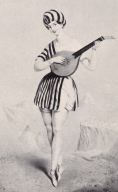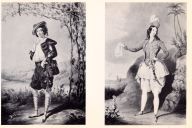 Dressing the Part
Dressing the Part
Dancing en pointe made the ballerina somewhat unsteady and
an attentive partner was required to provide stability and to act as the
dancer’s porter. Since the inclusion of a danseur
was out of the question,
women were recruited to act out the parts of men. The danseur
en travesti of previous generations was exchanged for the danseuse
en travesti in the nineteenth century. However, it must not be assumed that the female travesty dancer fooled
anyone into believing she was a
man, nor was that the intent. Her role was to heighten the eroticism for
the male spectator as he gazed upon the pas de deux en travesti where the
womanliness of both figures was explicitly showcased. As these images will
attest to, the figure cut by the danseuse in drag was far from masculine,
despite such devices as mustaches and goatees that some of them employed.
Janin, a severe critic of the
danseur, took great delight in the womanliness
of the travesty dancer, as is evident in his praise
of Thérèse Elssler (Chapman
1997): “Mlle Thérèse
Elssler is Fanny Elssler’s sister, elder brother, and ballet master
all in one. Mlle Thérèse is a tall and handsome person with
admirable legs; she will become the best danseur at the Opéra” (p.
219). With the establishment of these female danseurs, the eroticism of
the ballet was further enhanced. The necessity of partnering required for
pointe
work
allowed for the elaboration of the feminine spectacle in the “choreographic
play of female bodies” (Garafola
1985, p. 39) and further engaged
and titillated the male gaze.
However, it must not be assumed that the female travesty dancer fooled
anyone into believing she was a
man, nor was that the intent. Her role was to heighten the eroticism for
the male spectator as he gazed upon the pas de deux en travesti where the
womanliness of both figures was explicitly showcased. As these images will
attest to, the figure cut by the danseuse in drag was far from masculine,
despite such devices as mustaches and goatees that some of them employed.
Janin, a severe critic of the
danseur, took great delight in the womanliness
of the travesty dancer, as is evident in his praise
of Thérèse Elssler (Chapman
1997): “Mlle Thérèse
Elssler is Fanny Elssler’s sister, elder brother, and ballet master
all in one. Mlle Thérèse is a tall and handsome person with
admirable legs; she will become the best danseur at the Opéra” (p.
219). With the establishment of these female danseurs, the eroticism of
the ballet was further enhanced. The necessity of partnering required for
pointe
work
allowed for the elaboration of the feminine spectacle in the “choreographic
play of female bodies” (Garafola
1985, p. 39) and further engaged
and titillated the male gaze.